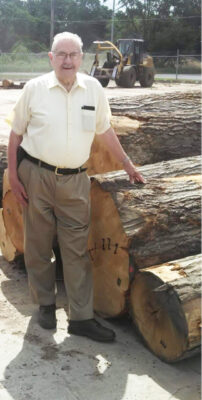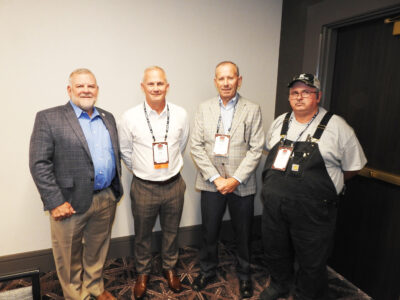Ontario Business Trends – April 2025
Hard and Soft Maple Remain Popular in Ontario As Prices Continue To Rise
With full winter weather upon us at press time, logging conditions were a challenge for certain areas, thus production statistics being down in those areas both in Ontario and in the Appalachian region. However, other areas reported increased sawmill production. Thus, end users were purchasing more aggressively. Green lumber supplies were readily available. Also, green lumber prices were rising for the No. 1 Common and Better Hard Maple and FAS and FAS1F Ash and Soft Maple.
Developing supplies of Ash were reported as limited, with markets readily absorbing quantities, and so for some grades prices are up. Kiln-dried business is steady, with inventories thin for No. 2A and Better.
Sawmills and loggers are avoiding Aspen to the extent possible. Green supplies have contracted over time, there is adequate No. 2B and Better available. The low grade stocks are problematic note sellers, although reduced mill output has pushed supplies closer to market’s needs for all grades. Prices are stable. While demand has not changed that much for this species, declining inventories firmed up kiln dried prices.
Basswood production is controlled due to salability of some grades and thicknesses, and a low return on processing this species. Harvesting continues for this specie, however, resulting in green Basswood more available on markets, but not overwhelming it. Mills and wholesalers state that sales are keeping pace with production.
Demand for Birch pertains mostly to color. Premium color materials are performing best, while off colors are difficult to sell. Green Birch markets are decent, but again color is a predominant seller.
Hard Maple continues to be popular on markets, with mills shipping total production. Demand for No. 1 Common and Better is stronger with prices up. Business for the lower grades are reported as controlled. Kiln-dried markets are varied noted contacts.
Kiln-dried Soft Maple business is described as good for only certain grades and thicknesses. Again, sales of premium colors for No. 1 Common and Better are best for this specie. It was noted that demand for No. 2A was weak. Green Soft Maple supplies increased since mid-February, and end users are welcoming additional No. 1 Common and Better production.
Some contacts note that Red Oak sales have been steady for a while, with No. 1 Common business picking up, reducing available supplies and pushing prices higher. Green Red Oak production is also satisfying demand report contacts. Sales of kiln-dried White Oak have slowed to several international customers, and some contacts note domestic business is not as strong as this time last year. This specie is still one of choice by designers and consumers. Green White Oak demand is holding well, with mills shipping total production note contacts.
Reforestation Resumes
The federal government is investing $900,000 for planting trees in the Ogoki Forest, 400 kilometres northeast of Thunder Bay, which was destroyed by fire in 2023. This investment supports the planting of 800,000 trees over 450 hectares, rehabilitates ecosystems destroyed by wildfires and restores the habitat of woodland caribou, moose and black bears. Energy and Natural Resources Minister Jonathan Wilkinson announced the funding on January 15, saying it will help achieve the federal government’s goal of planting two billion trees over the next decade.
This project is driven by the support of Forests Canada, Tree Canada and the Arbor Day Foundation, Chilly Moose Ltd. and Orca Intelligence Inc. Their vital funding not only makes this large-scale restoration effort possible but underscores the transformative power of strategic partnerships in tackling the urgent challenge of reforesting wildfire-devastated landscapes and restoring ecological balance.
These organizations play a pivotal role in advancing Canada’s reforestation goals, ensuring that critical ecosystems like those found in the Ogoki Forest are not only restored but strengthened for the future. Their support extends beyond funding—it represents a unified vision for mitigating climatic disruptions, preserving biodiversity and fostering sustained reforestation development in partnership with local communities and Indigenous leadership. Together, these contributions pave the way for impactful, long-lasting, positive change in regions hardest hit by environmental crises.
Canada secured a 30 day pause on tariffs threatened by Trump after promising to deploy more resources to the Canada-U.S. border. Canada is implementing a $1.3 billion border plan – reinforcing the border with new choppers, technology and personnel, enhanced coordination with Americans and increased resources to stop the flow of fentanyl. Trudeau also announced to appoint a “fentanyl czar”, border security and a Canada-U.S. joint strike force to “combat organized crime, fentanyl and money laundering”. Trudeau also promised $200 million towards a new intelligence directive on organized crime and fentanyl.
Economists have been revising their forecasts for Canada’s economy since the tariffs were announced. Canadian Bank of Imperial Commerce outlined a scenario in which real GDP would fall five percentage points below what was initially projected by the end of 2026. The Bank of Canada said in early February that a protracted trade war would lead to a potential three percent hit to Canada’s GDP.
Some U.S. government officials pushed back against the tariffs, asking for exemptions on behalf of American farmers, and other products that have integrated their state economies with the Canadian economy. These tariffs will impose significant burden on many families, manufacturers, the forest products industry, small businesses, lobstermen and agricultural producers. It was said that 95 percent of heating oil used by most miners to heat their homes comes from refineries in Canada.
These tariffs will not only raise costs for Canadians, the U.S. Chamber of Commerce issued a statement warning of the potential costs of the tariffs on American consumers.
“The President is right to focus on major problems like our broken border and the scourge of fentanyl, but the imposition of tariffs under IEEPA is unprecedented, won’t solve these problems, and will only raise prices for American families and upend supply chains,” said senior vice-president John Murphy.
Canada had planned to roll out its initial phase of retaliatory tariffs, at the time of this writing, following the U.S. announcement, levying a 25 percent tax on $30 billion of mostly U.S. consumer goods. The full list was released by Finance Canada on Sunday and included poultry, grains, alcohol, fruits, vegetables and soaps.
As it stands, we are all still in a waiting mode to see what agreements will be reached between Canada, the U.S. and Mexico.







